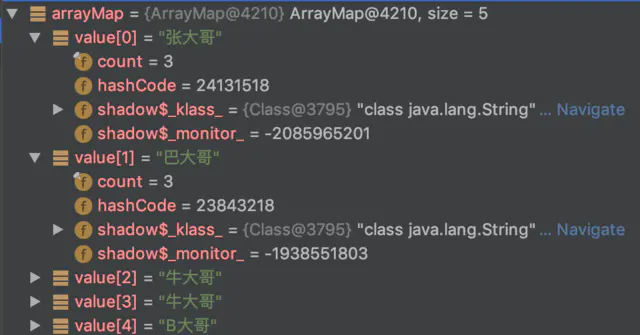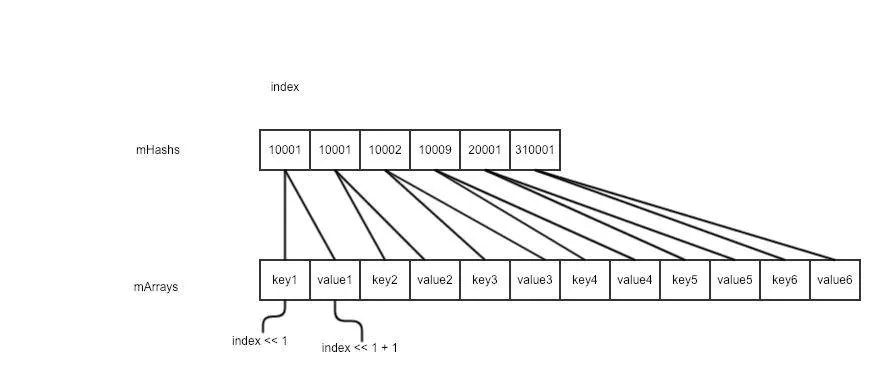一次面试被问到 ArrayMap,原理及源码分析详解
一、前言
在 《SparseArray 详解及源码简析》中,我们熟悉了 SparseArray 的基本用法、特点以及实现原理。而在 Android SDK 的这个工具包中还有一个同样重要的数据结构 ArrayMap,其目的也是在当数据量较小,比如几百个的时候,可以用来替代 HashMap,以提高内存的使用效率。
如果对 HashMap 的实现感兴趣的话,可以看看《HashMap 详解以及源码分析》,而这篇文章就来了解一下 ArrayMap 的使用及其实现原理。
二、 源码简析
1. demo 及其简析
分析代码之前同样先看一段 demo,后面同样通过 demo 进行实现原理的分析。
ArrayMap<String,String> arrayMap = new ArrayMap<>();
arrayMap.put(null,"张大哥");
arrayMap.put("abcd","A 大哥");
arrayMap.put("aabb","巴大哥");
arrayMap.put("aacc","牛大哥");
arrayMap.put("aadd","牛大哥");
arrayMap.put("abcd","B 大哥");
Set<ArrayMap.Entry<String,String>> sets = arrayMap.entrySet();
for (ArrayMap.Entry<String,String> set : sets) {
Log.d(TAG, "arrayMapSample: key = " + set.getKey() + ";value = " + set.getValue());
}
代码中,实际插入了 6 个 Key-Value,然而输出只有 5 个,其中 Key 为 “abcd” 的重复了而发生了覆盖。另外,还有一点注意的是 null 为 key 是允许插入的。以下是其输出的结果。
arrayMapSample: key = null;value = 张大哥 arrayMapSample: key = aabb;value = 巴大哥 arrayMapSample: key = aacc;value = 牛大哥 arrayMapSample: key = aadd;value = 牛大哥 arrayMapSample: key = abcd;value = B 大哥
通过 Android Studio 的 Debug 功能,也可以简单观察一下其在内存中的存储。

2.源码分析
先来简单看一下 ArrayMap 的类图结构。

与 HashMap 不同的是,它是直接实现自接口 map。同样,存储 key-value 的方式也不同。ArrayMap 是通过数组直接存储了所有的 key-value。其中,mHashes 在 index 处存储了 key 的 hash code,而 mArray 则在 hash code 的 index<<1 处存储 key,在 index<<1 + 1 处存储 value。简单点说就是偶数处存储 key,相邻奇数处存储 value。
ArrayMap 的初始化
/**
Create a new empty ArrayMap. The default capacity of an array map is 0, and
will grow once items are added to it.
*/
public ArrayMap() {
this(0, false);
}
/**
Create a new ArrayMap with a given initial capacity.
*/
public ArrayMap(int capacity) {
this(capacity, false);
}
/** {@hide} */
public ArrayMap(int capacity, boolean identityHashCode) {
mIdentityHashCode = identityHashCode;
// If this is immutable, use the sentinal EMPTY_IMMUTABLE_INTS
// instance instead of the usual EmptyArray.INT. The reference
// is checked later to see if the array is allowed to grow.
if (capacity < 0) {
mHashes = EMPTY_IMMUTABLE_INTS;
mArray = EmptyArray.OBJECT;
} else if (capacity == 0) {
mHashes = EmptyArray.INT;
mArray = EmptyArray.OBJECT;
} else {
allocArrays(capacity);
}
mSize = 0;
}
ArrayMap 的构造方法有 3 个重载的版本都列在上面了,一般我们都用默认的构造方法,那也就是说默认容量大小就是 0,需要等待到插入元素时才会进行扩容的动作。构造方法中的另一个参数 identityHashCode 控制 hashCode 是由 System 类产生还是由 Object.hashCode() 返回。
这两者之间的实现其实没太大区别,因为 System 类最终也是通过 Object.hashCode() 来实现的。其主要就是对 null 进行了特殊处理,比如一律为 0。而在 ArrayMap 的 put() 方法中,如果 key 为 null 也将其 hashCode 视为 0 了。所以这里 identityHashCode 为 true 或者 false 都是一样的。
插入元素 put()
public V put(K key, V value) {
final int osize = mSize;
// 1.计算 hash code 并获取 index
final int hash;
int index;
if (key == null) {
// 为空直接取 0
hash = 0;
index = indexOfNull();
} else {
// 否则取 Object.hashCode()
hash = mIdentityHashCode ? System.identityHashCode(key) : key.hashCode();
index = indexOf(key, hash);
}
// 2
.如果 index 大于等于 0 ,说明之前存在相同的 hash code 且 key 也相同,则直接覆盖
if (index >= 0) {
index = (index<<1) + 1;
final V old = (V)mArray[index];
mArray[index] = value;
return old;
}
// 3.如果没有找到则上面的 indexOf() 或者 indexOfNull() 就会返回一个负数,而这个负数就是由将要插入的位置 index 取反得到的,所以这里再次取反就变成了将进行插入的位置
index = ~index;
// 4.判断是否需要扩容
if (osize >= mHashes.length) {
final int n = osize >= (BASE_SIZE*2) ? (osize+(osize>>1))
: (osize >= BASE_SIZE ? (BASE_SIZE*2) : BASE_SIZE);
if (DEBUG) Log.d(TAG, "put: grow from " + mHashes.length + " to " + n);
final int[] ohashes = mHashes;
final Object[] oarray = mArray;
// 5.申请新的空间
allocArrays(n);
if (CONCURRENT_MODIFICATION_EXCEPTIONS && osize != mSize) {
throw new ConcurrentModificationException();
}
if (mHashes.length > 0) {
if (DEBUG) Log.d(TAG, "put: copy 0-" + osize + " to 0");
// 将数据复制到新的数组中
System.arraycopy(ohashes, 0, mHashes, 0, ohashes.length);
System.arraycopy(oarray, 0, mArray, 0, oarray.length);
}
// 6.释放旧的数组
freeArrays(ohashes, oarray, osize);
}
if (index < osize) {
// 7.如果 index 在当前 size 之内,则需要将 index 开始的数据移到 index + 1 处,以腾出 index 的位置
if (DEBUG) Log.d(TAG, "put: move " + index + "-" + (osize-index)
" to " + (index+1));
System.arraycopy(mHashes, index, mHashes, index + 1, osize - index);
System.arraycopy(mArray, index << 1, mArray, (index + 1) << 1, (mSize - index) << 1);
}
if (CONCURRENT_MODIFICATION_EXCEPTIONS) {
if (osize != mSize || index >= mHashes.length) {
throw new ConcurrentModificationException();
}
}
// 8.然后根据计算得到的 index 分别插入 hash,key,以及 code
mHashes[index] = hash;
mArray[index<<1] = key;
mArray[(index<<1)+1] = value;
mSize++;
return null;
}
put 方法调用了其他几个内部的方法,其中关于扩容以及如何释放空间,申请新的空间这些,从算法层来讲其实不重要,只要知道一点就是,扩容会发生数据的复制,这个是会影响效率的就可以了。
而与算法相关性较大的 indexOfNull() 方法以及 indexOf() 方法的实现。由于这两个方法的实现基本一样,因此这里只分析 indexOf() 的实现。
int indexOf(Object key, int hash) {
final int N = mSize;
// Important fast case: if nothing is in here, nothing to look for.
if (N == 0) {
return ~0;
}
int index = binarySearchHashes(mHashes, N, hash);
// If the hash code wasn't found, then we have no entry for this key.
if (index < 0) {
return index;
}
// If the key at the returned index matches, that's what we want.
if (key.equals(mArray[index<<1])) {
return index;
}
// Search for a matching key after the index.
int end;
for (end = index + 1; end < N && mHashes[end] == hash; end++) {
if (key.equals(mArray[end << 1])) return end;
}
// Search for a matching key before the index.
for (int i = index - 1; i >= 0 && mHashes[i] == hash; i--) {
if (key.equals(mArray[i << 1])) return i;
}
// Key not found -- return negative value indicating where a
// new entry for this key should go. We use the end of the
// hash chain to reduce the number of array entries that will
// need to be copied when inserting.
return ~end;
}
其实它原来的注释已经很详细了,详细的步骤是:
(1) 如果当前为空表,则直接返回 ~0,注意不是 0 ,而是最大的负数。
(2) 在 mHashs 数组中进行二分查找,找到 hash 的 index。
(3) 如果 index < 0,说明没有找到。
(4) 如果 index >= 0,且在 mArray 中对应的 index<<1 处的 key 与要找的 key 又相同,则认为是同一个 key,说明找到了。
(5) 如果 key 不相同,说明只是 hash code 相同,那么分别向后和向前进行搜索,如果找到了就返回。如果没找到,那么对 end 取反就是当前需要插入的 index 位置。
再回过头来看 put() 方法, put() 方法的具体实现都在源码中加以了详细的说明,感兴趣的可以详细阅读一下。而从 put 方法得出以下几个结论:
(1) mHashs 数组以升序的方式保存了所有的 hash code。
(2) 通过 hash code 在 mHashs 数组里的 index 值来确定 key 以及 value 在 mArrays 数组中的存储位置。一般来说分别就是 index << 1 以及 index << 1 + 1。再简单点说就是 index * 2 以及 index * 2 + 1。
(3) hashCode 必然可能存在冲突,这里是怎么解决的呢?这个是由上面的第 3 步和第 7 步所决定。第 3 步是得出应该插入的 index 的位置,而第 7 步则是如果 index < osize ,则说明原来 mArrays 中必然已经存在相同 hashCode 的值了,那么就把数据全部往后移一位,从而在 mHashs 中插入多个相同的 hash code 并且一定是连接在一起的,而在 mArrays 中插入新的 key 和 value,最终得以解决 hash 冲突。
上面的结论可能还是让人觉得有点晕,那么再来看看下面的图吧,就一定能明白了。

上面图说, index == 0 时 和 index == 1 时的 hash code 是一样的,说明 key1 与 key2 的 hash code 是一样的,也就是存在 hash 冲突了。那么,如上,这里的解决办法就是 hash code 存储了 2 份,而 key-value 分别存储一份。
get() 方法
public V get(Object key) {
final int index = indexOfKey(key);
return index >= 0 ? (V)mArray[(index<<1)+1] : null;
}
主要就是通过 indexOfKey() 计算出 index,而 indexOfKey() 的实现就是调用 indexOfNull () 和 indexOf(),其具体的实现已经上面分析过了。这里如果返了 index >= 0,则说明一定是找到了,那么根据前面的规则,在 mArray 中,index<<1 + 1 就是所要获取的 value 了。
remove() 方法
public V remove(Object key) {












评论